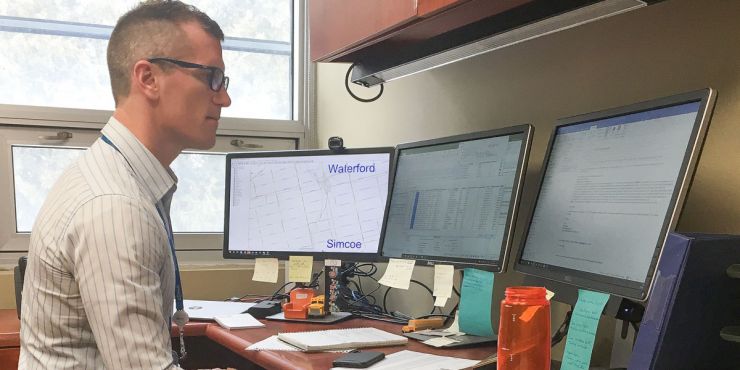 |
| Above: Phil Kuckyt, Manager of Transportation Services keeps track of the many bus routes servicing Grand Erie, Brant Haldimand Norfolk Catholic District School Board, and Conseil Scolaire Catholique MonAvenir students and families. |
On the Job with Philip Kuckyt, Manager of Transportation Services
THURSDAY, JAN. 26, 2023
A
s sure as the winds will change, Philip Kuckyt, Manager of Transportation Services, can rely on the fact that each day on the job will be different. But unlike many professions, the weather isn’t just a metaphor for him.
![Cultural-Kit-Orange-Shirt-Day[2].jpg](/application/files/thumbnails/small/7216/7476/0766/kuckyt_phil-FB-Instagram02_1200px.jpg) |
| Above: Phil Kucky and the Transportation Services team, discuss weather projections and route options to maximize school bus safety during inclement weather days. |
“I’m always up early, but when there’s the potential for inclement weather, my work day starts around 4:30 a.m., and my office at that point is my kitchen table since I need to be close to my phone and computer first thing,” says Kuckyt of the make-shift command central he sets up on early mornings in his home in Cayuga. “During this time, I’m looking at updated forecasts and projections, checking in with a meteorologist about how and when those weather patterns are expected to affect specific areas within Grand Erie, and speaking with municipal road supervisors and school bus company operators about current conditions as they’re experiencing them.”
There are a lot of variables Kuckyt needs to consider long before anyone else’s alarm clock goes off, because the decision to close schools is not taken lightly.
“We’re looking at everything from a school-bus perspective: the traction on buses is very different compared to an all-wheel drive vehicle. The buses are required to make stops at locations cars normally don’t, and they don’t have the option of changing their route to avoid secondary roads that haven’t been plowed yet, for example,” he says. “The track of weather systems can affect certain areas very differently as well, so knowing what municipalities are utilizing to treat roads and deal with conditions, along with their timelines for completion, feeds into the decision-making process.”
![Cultural-Kit-Orange-Shirt-Day[2].jpg](/application/files/thumbnails/small/8316/7476/0883/kuckyt_phil-FB-Instagram03_1200px.jpg) |
| Above: On any day with the potential for inclement weather, Phil starts his work day at 4:30 a.m. with his kitchen table serving as a makeshift office. |
The process also involves a group discussion with superintendents about the best options available, considering both morning and afternoon windows of school bus travel. Occasionally, conditions amount to the perfect storm, and Kuckyt’s department, which is a consortium owned and operated by three school boards – Grand Erie, Brant Haldimand Norfolk Catholic District School Board, and Conseil Scolaire Catholique MonAvenir – makes the recommendation to cancel transportation services in the interest of safety. When that happens, the boards close schools to staff and students for the day, and the information is communicated to all stakeholders by 6:30 a.m. by the boards’ communications teams and by the consortium.
“We’re making the most informed decision we possibly can,” says Kuckyt of this pre-dawn collaborative effort.
Kuckyt got started in this field following the completion of a business degree at Wilfrid Laurier University. The opportunity came up to apply to a manager-development program in the transportation field, and he was one of two successful candidates. The on-the-job education took him to Toronto, Ottawa, and Edmonton, gaining practical knowledge of dispatching, preventative maintenance, finance, and human resources management he couldn’t have learned as effectively from a textbook.
He’s been in his current role for 10 years, but Kuckyt’s history in Grand Erie goes back further than that. He’s an alum of Cayuga Secondary School, born and raised in the rural town he now makes his family home with his wife, a Grand Erie teacher, their three school-aged children, and golden retriever Brody, who accompanies him on early-morning walks which double as an opportunity to check on road conditions.
Kuckyt covers breakfast and lunch duty in his busy household before heading into the office to meet with his team.
“Every day is uneventful, until it’s not,” he says of the fast-paced field, where business-as-usual means keeping track of annual goals, optimizing routes, managing contracts and procurements, tracking key performance indicators, metrics, and as well as the budgets. It also means answering questions from stakeholders – school administrators and parents – and evaluating decision making. “We’re always asking what we can learn from a given scenario.”
Kuckyt’s responsibilities are also a direct extension of Grand Erie’s Multi-Year Plan. With nearly half of all students using transportation, the service has the ability to set a positive tone for the rest of their day.
“We get students to school, ready and able to learn and succeed,” he says. “The school bus is an extension of the classroom in many ways, so ensuring an inclusive, respectful environment on the bus can have an important impact on student well-being and achievement.”
Well-being is something Kuckyt takes very seriously, and his team uses the lunch break to prioritize exercise. A group of transportation-department staff members can often be found in the common area at the Joseph Brant Learning Centre during their lunch hour, keeping up with a challenging Jillian Michaels workout.
“When you add physical activity to your day, it brings a balance that can help you perform better at work,” he says. “It helps relieve stress, keeps you healthy, which can help minimize sick days, and when you work out with coworkers, it further develops relationships which can build a stronger team dynamic.”
Kuckyt says that the people he works with in the department and at the Board are a large part of what makes the job so positive.
“It’s a healthy, open, collaborative place, and I enjoy coming to work every day” Kuckyt says. “There’s a mix of financial, safety, and operational responsibilities that my particular role is entrusted to, and that means the work itself is incredibly fulfilling.”
Follow this link for more information about inclement weather impacts on schools and transportation.
Good Food Adds Up to Good Learning at Courtland Pubic School
Evidence suggests that breakfast and snack programs in schools:
- Improves children’s school performance, memory and test grades
- Enhances students’ physical, emotional, social and intellectual development
- Increases attendance rates, particularly for nutritionally at risk children
- Provides additional time for children to eat and drink nutritious breakfasts and snacks
- Provides energy for students to be more physically
- Enhances nutritional status of students by replacing the consumption of foods with low nutritional value with more nutritious choices, such as more vegetables and fruit
- Promotes a sense of community by bringing people together to ensure all children are well-nourished
- Leads to better dietary habits by increasing the frequency of eating breakfast
- Reduces the prevalence of vitamin and mineral deficiencies
With the generous support of the Child Nutrition Network and the Grand Erie District School Board, the school was able to renovate a room in the school into a nutrition program kitchen. Funds provided by the Child Nutrition Network and school fundraising monies purchase the good food and materials needed to run the program.
Every morning at 8 a.m., parent volunteers and their children arrive to prepare and distribute the food for the day. This program would not happen without their enthusiastic support.
Each serving of food includes a dairy product (i.e. yogurt, cheese string), a grain product (i.e. crackers, mixed cereal, muffin, whole wheat bun) and a fruit product (i.e. apple, banana, clementine orange, grapes, juice) or a vegetable product (i.e. cucumber slices, raw carrots). A container filled with food is delivered to each classroom and as children get settled for a day of learning, staff and students are encouraged to help themselves to a delicious and nutritious start to the day.
“Nutrition programs, such as the one at Courtland Public School, are happening in many schools within the Grand Erie District School Board. It’s a huge effort supported by the Board, volunteers and community agencies. Working together, it’s amazing what can be done. We feel most grateful to have this opportunity for our Courtland school community”, says principal Deb Opersko.
Roots of Empathy
Courtland Public School offers the Roots of Empathy program in our Kindergarten A classroom. Our Early Childhood Educator, Mrs. L. Wildman is a trained Roots of Empathy instructor. Our Roots of Empathy baby and her mom are welcome visitors to the classroom.
An explanation of program, from the Roots of Empathy website is included below:
Roots of Empathy is an evidence-based classroom program that has shown significant effect in reducing levels of aggression among schoolchildren by raising social/emotional competence and increasing empathy. The program reaches elementary schoolchildren from Kindergarten to Grade 8. In Canada, the program is delivered in English and French and reaches rural, urban, and remote communities including Aboriginal communities. Roots of Empathy is also delivered in New Zealand, the United States, Isle of Man, the Republic of Ireland, Northern Ireland and Scotland.
Emotional Literacy
At the heart of the program are a neighbourhood infant and parent who visit the classroom every three weeks over the school year. A trained Roots of Empathy Instructor coaches students to observe the baby's development and to label the baby's feelings. In this experiential learning, the baby is the "Teacher" and a lever, which the instructor uses to help children identify and reflect on their own feelings and the feelings of others. This "emotional literacy" taught in the program lays the foundation for more safe and caring classrooms, where children are the "Changers". They are more competent in understanding their own feelings and the feelings of others (empathy) and are therefore less likely to physically, psychologically and emotionally hurt each other through bullying and other cruelties. In the
Roots of Empathy program children learn how to challenge cruelty and injustice. Messages of social inclusion and activities that are consensus building contribute to a culture of caring that changes the tone of the classroom. The Instructor also visits before and after each family visit to prepare and reinforce teachings using a specialized lesson plan for each visit. Research results from national and international evaluations of Roots of Empathy indicate significant reductions in aggression and increases in pro-social behaviour.More News

